Birds are a magnificent family of animals that have captivated people for centuries. While many species of birds can be found worldwide, Kayin is home to some of the most beautiful and diverse birds in the world.
Kayin is a paradise for bird lovers, from colorful parrots to graceful swans. Here, you will find a wide variety of species and unique habitats to explore. Whether you are a beginner or an experienced bird watcher, Kayin has something to offer everyone.
14 Birds to Watch in Kayin
Kayin is a state in Myanmar that is rich in natural beauty and cultural diversity. It is also a haven for birdwatchers, as it hosts a variety of bird species, some of which are rare or endemic to the region. Here are 14 birds that you can watch in Kayin
1. Lesser Whistling Duck
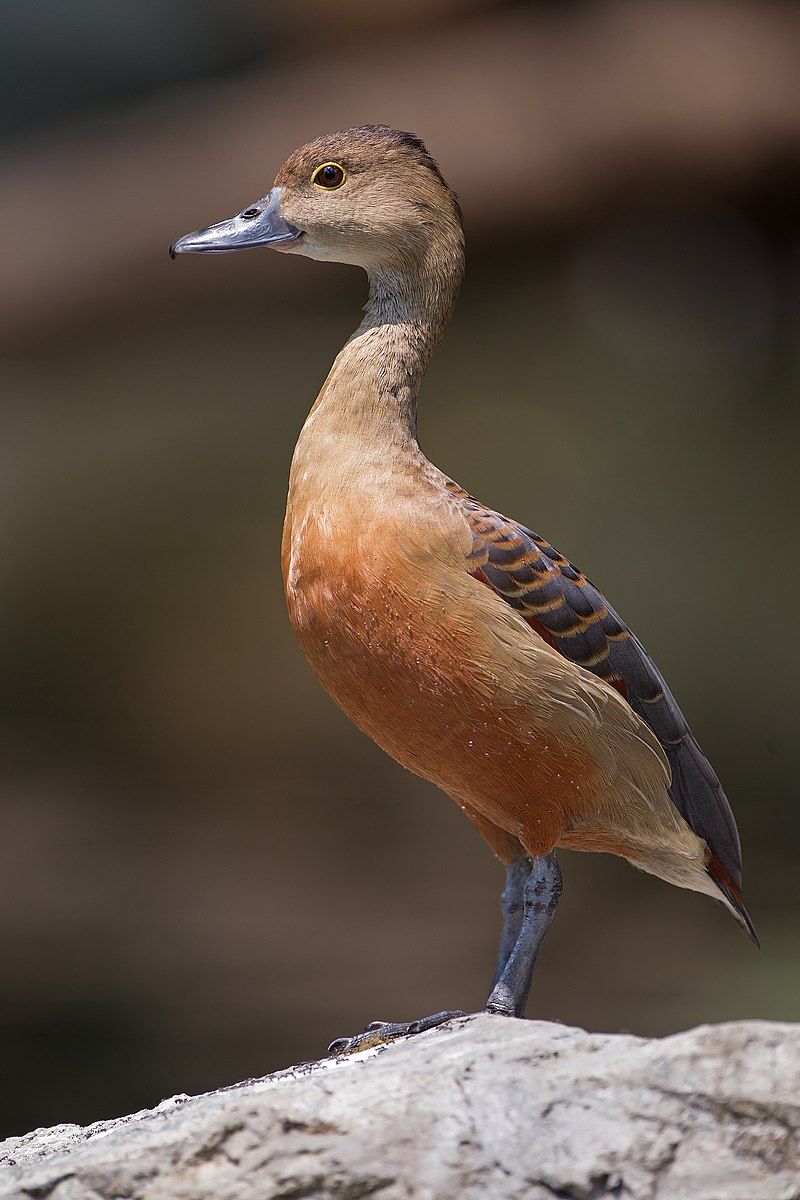
The Lesser Whistling Duck is a duck species native to the Indian subcontinent and Southeast Asia. It is also called the Indian Whistling Duck or the Lesser Whistling Teal. These ducks are nocturnal, meaning they feed during the night.
During the day, they are often seen in large flocks around bodies of water, such as lakes and wet paddy fields. The Lesser Whistling Duck is a small duck with a body length of around 33-38 cm. They have a narrow bill that is red in color and a white earring.
The duck’s plumage is generally brownish-grey, with a lighter underside. The Lesser Whistling Duck is a social species often seen in large flocks. They are also quite vocal, giving out a distinctive whistling call.
This call is used to communicate with one another and to ward off potential predators. The Lesser Whistling Duck is an essential species in its native range, providing an important food source for both people and predators.
| Kingdom | Animalia |
| Phylum | Chordata |
| Class | Aves |
| Order | Anseriformes |
| Family | Anatidae |
| Genus | Dendrocygna |
| Species | D. javanica |
2. Indian Spot-billed Duck
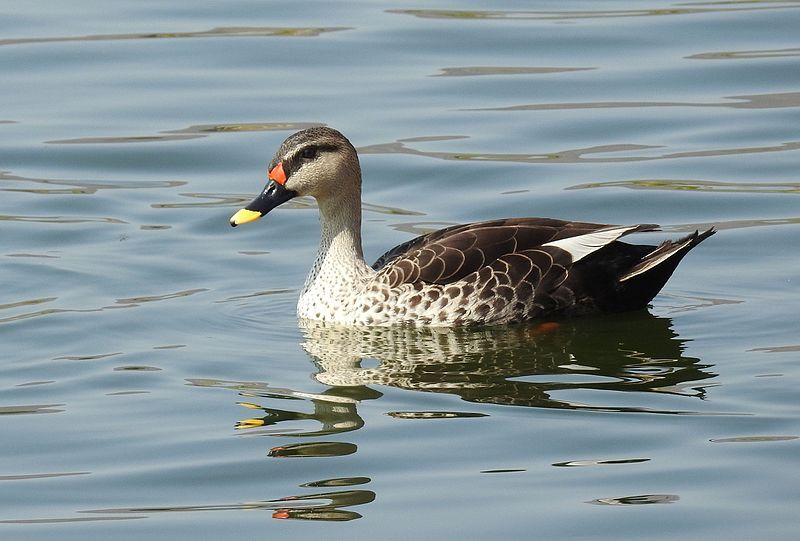
The Indian spot-billed duck is a sizeable dabbling duck native to the Indian subcontinent. It is a non-migratory duck and breeds in freshwater wetlands throughout the region.
The duck’s name derives from the red spot found at the base of the bill, which is only present in the mainland Indian population. The spot-billed duck is a large bird, typically around 42-45 cm long, with a wingspan of around 65-70 cm.
It has a distinctive brownish-gray plumage on its back and head, with a white-gray chest. The bill is yellowish-green, with a unique red spot at the base.
Males and females have similar appearances, but males tend to be slightly larger than females. The Indian spot-billed duck is a strong swimmer and can be found in various wetlands, including rivers, ponds, lakes, and marshes.
It feeds on aquatic vegetation, small fish, insects, and other invertebrates. The Indian spot-billed duck is a non-migratory species and will often remain in the same area year-round.
Breeding generally takes place during the wet season, and pairs will form and stay together until the end of the season. The female will lay a clutch of 4-10 eggs, which she incubates alone. The chicks can fly after around 45 days.
The Indian spot-billed duck is listed as a species of most minor concern by the IUCN Red List, although its numbers are declining due to habitat destruction and hunting.
| Kingdom | Animalia |
| Phylum | Chordata |
| Class | Aves |
| Order | Anseriformes |
| Family | Anatidae |
| Genus | Anas |
| Species | A. poecilorhyncha |
3. Little Grebe
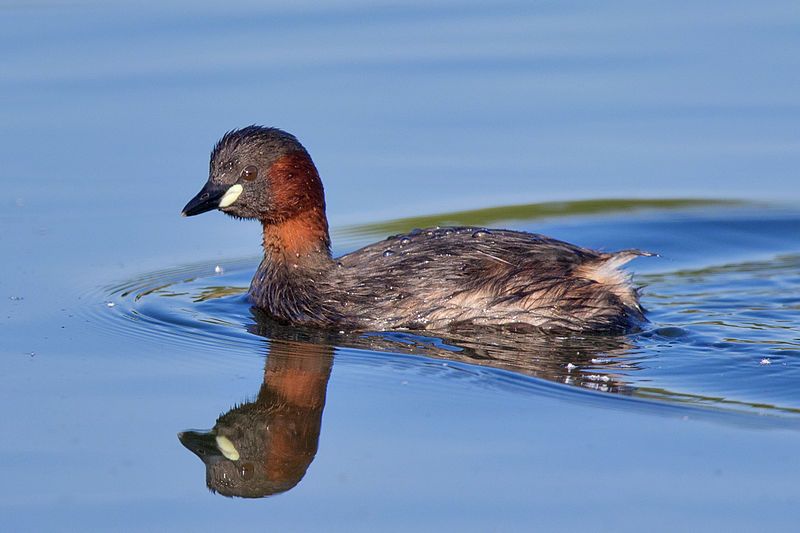
The little grebe, also known as dabchick, belongs to a family of birds known as grebes. These water birds are named after the Ancient Greek word thus, which means “fast,” and bapto, which means “to sink under.”
The species ruficollis is derived from the Latin words Rufus, meaning “red,” and Collis, meaning “necked,” which is derived from the Latin phrase collum, meaning “neck.” This grebe species is identified by its reddish neck and quick swimming abilities.
| Kingdom | Animalia |
| Phylum | Chordata |
| Class | Aves |
| Order | Podicipediformes |
| Family | Podicipedidae |
| Genus | Tachybaptus |
| Species | T. ruficollis |
4. Cotton Pygmy Goose
The Cotton Pygmy Goose, also known as the Cotton Teal, is a small duck that originates from parts of Asia. Specifically, it is found in Southeast Asia and extends south and east to Queensland, Australia.
In Queensland, the Cotton Pygmy Goose is called the White-Quilled Pygmy Goose. This is a perching duck, meaning it spends much of its time perched on trees and branches.
The Cotton Pygmy Goose is a migratory species that travels to different parts of Asia during the other seasons in search of food and suitable habitats.
The Cotton Pygmy Goose is widespread among bird watchers and hunters because of its small size and beautiful plumage.
| Kingdom | Animalia |
| Phylum | Chordata |
| Class | Aves |
| Order | Anseriformes |
| Family | Anatidae |
| Genus | Nettapus |
| Species | N. coromandelianus |
5. Blue Breasted Quail
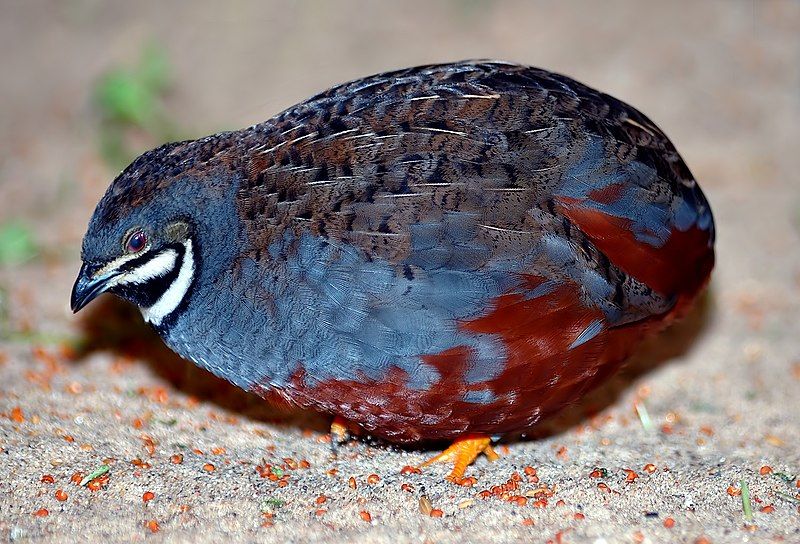
The king quail is an Old World species found in the Phasianidae family. A variety of different names, such as the blue-breasted quail, Asian blue quail, Chinese painted quail, or Chung-Chi, also known.
It is a small game bird with a body length of approximately 20 cm and a weight of around 70-90 g. The male king quail has a grey crown, a black chin, a white throat and chest, and a brownish-blue back.
Females have a brownish-grey crown, a grey chin, and a grey throat and chest. Both males and females have a reddish-brown tail and wings. The king quail is found in open grasslands, woodlands, and scrublands of Southeast Asia and East Asia.
It is a ground-dwelling species that feeds mainly on seeds, insects, and berries. It is usually seen in small groups, although sometimes in flocks of up to thirty birds.
The king quail is also known to keep watch over the flock, and it has a loud call to alert other members of its group. The king quail is considered a vulnerable species due to its limited range and population decline.
It is threatened by habitat loss and hunting for food. Conservation efforts are ongoing to help protect this species from further decline.
| Kingdom | Animalia |
| Phylum | Chordata |
| Class | Aves |
| Order | Galliformes |
| Family | Phasianidae |
| Genus | Synoicus |
| Species | S. chinensis |
6. Green Imperial Pigeon
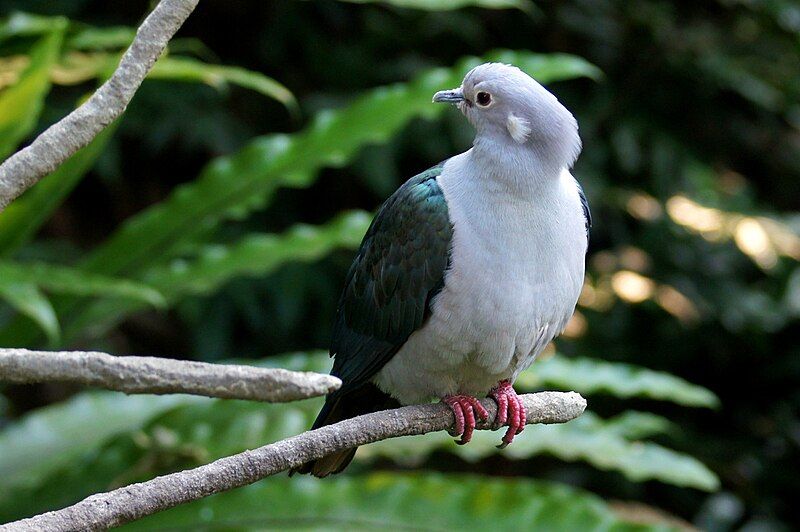
The green imperial pigeon is a large species of forest pigeon that lives in many areas. This species is native to Nepal, southern India, and Sri Lanka, and it has also been found in the east of south China, Indonesia, and the Philippines.
This pigeon species is found in various habitats, such as tropical forests, mangroves, and montane forests. The green imperial pigeon is a medium-sized pigeon with a dark green head, neck, and breast. Its wings and tail are gray, and its belly is white.
It feeds on fruit and berries and occasionally eats small invertebrates. This pigeon species is known for its loud, raucous call, usually heard in the early morning and late evening.
The green imperial pigeon is a highly social species often seen in large flocks. It is an essential species in many parts of its range, as its droppings are valuable sources of nutrients for the forests it inhabits.
| Kingdom | Animalia |
| Phylum | Chordata |
| Class | Aves |
| Order | Columbiformes |
| Family | Columbidae |
| Genus | Ducula |
| Species | D. aenea |
7. Pied Imperial Pigeon
The pied imperial pigeon is a species of pigeon that is quite large and has a distinct pied coloration. It is native to Southeast Asia, ranging from Myanmar and Thailand to Indonesia, the Philippines, and the Bird’s Head Peninsula of New Guinea.
Its habitat includes various environments, such as forests, woodlands, mangroves, plantations, and scrub. This species is highly adaptable and can thrive in multiple habitats, making it a thriving species in its native region.
The pied imperial pigeon is an important food source for many people in Southeast Asia, and its population is relatively stable despite some localized threats. The bird also has cultural significance and is revered by some cultures as a symbol of peace and prosperity.
| Kingdom | Animalia |
| Phylum | Chordata |
| Class | Aves |
| Order | Columbiformes |
| Family | Columbidae |
| Genus | Ducula |
| Species | D. bicolor |
8. Pink-headed Duck
The pink-headed duck is a large diving duck native to parts of India, Maharashtra, Bangladesh, and Myanmar. It was once widely found in these areas, but since the 1950s, it has not been seen, leading to fears that it may be extinct.
Numerous searches have been conducted to verify the duck’s continued existence, but so far, they have been unsuccessful.
This has led many experts to believe that the species may indeed be extinct or critically endangered. The pink-headed duck is iconic, as its distinctive pink head and neck set it apart from other ducks.
It feeds mainly on aquatic plants and insects and spends much of its time in the water.
It is believed that habitat destruction and hunting have been major contributing factors to its decline. While conservation efforts are underway, it remains unclear if they will be enough to save the species.
The pink-headed duck’s extinction would be a significant loss for the once-inhabited areas.
It reminds us of the importance of protecting our environment and wildlife and the need to preserve species before they reach the brink of extinction.
While it is still possible that the pink-headed duck may yet be found, it is a sad reminder of what can happen when conservation efforts are neglected.
| Kingdom | Animalia |
| Phylum | Chordata |
| Class | Aves |
| Order | Anseriformes |
| Family | Anatidae |
| Genus | Rhodonessa |
| Species | R. caryophyllacea |
9. Silver Pheasant
The silver pheasant is a species found in forests in mainland Southeast Asia and eastern and southern China.
It is mainly found in mountainous areas, but there is also an introduced population of silver pheasants on Victoria Island in Nahuel Huapi Lake, Neuquén, Argentina. The male silver pheasant is black and white, while the female is mainly brown.
This is a typical pattern in birds, as males tend to have more vibrant colors to attract mates. The silver pheasant is a beautiful bird, with its striking black and white feathers and the subtle brown feathers of the female.
Its habitat is mainly forests, and it is omnivorous, feeding on small insects, fruit, seeds, and buds. Despite its beauty, the silver pheasant is threatened by habitat destruction and hunting. Conservation efforts must be made to ensure that the species continues to thrive.
| Kingdom | Animalia |
| Phylum | Chordata |
| Class | Aves |
| Order | Galliformes |
| Family | Phasianidae |
| Genus | Lophura |
| Species | L. nycthemera |
10. Long-billed Partridge
The long-billed partridge is a species of bird belonging to the family Phasianidae. It is a medium-sized bird, measuring between 14 and 18 inches long and weighing up to 1.2 pounds. Its long bill is unique among partridges, and its legs and feet are solid and robust.
Its plumage features a mix of gray, brown, black, and white feathers, used for camouflage when perched or on the ground. The long-billed partridge is found in open woodlands and scrub habitats across large parts of Africa, the Middle East, and Asia.
It feeds mainly on seeds, grains, and insects and will also scavenge for food. It prefers to live in pairs or small groups and is well known for its loud call, a series of whistles or chirps.
The long-billed partridge is a shy bird that is generally wary of humans. It is not considered to be threatened, and its population is stable.
| Kingdom | Animalia |
| Phylum | Chordata |
| Class | Aves |
| Order | Galliformes |
| Family | Phasianidae |
| Genus | Rhizothera |
| Species | R. longirostris |
11. Orange-breasted Green Pigeon
The orange-breasted green pigeon is a species native to tropical Asia, ranging from the Himalayas to parts of the Indian Subcontinent and Southeast Asia.
These birds are notable for their vibrant orange-hued breast, a striking contrast against their otherwise green plumage.
They are typically found in pairs or small flocks, foraging for food on low-growing trees and shrubs. Like other green pigeon species, the orange-breasted green pigeon feeds mainly on small fruits.
They will quietly move through the foliage, searching for berries, figs, and other edible items, and often share trees with different species of birds. This bird is somewhat timid and will usually fly away if disturbed.
However, they can be coaxed to approach closer with patience and the right food.
| Kingdom | Animalia |
| Phylum | Chordata |
| Class | Aves |
| Order | Columbiformes |
| Family | Columbidae |
| Genus | Treron |
| Species | T. bicinctus |
12. Red-crested Pochard
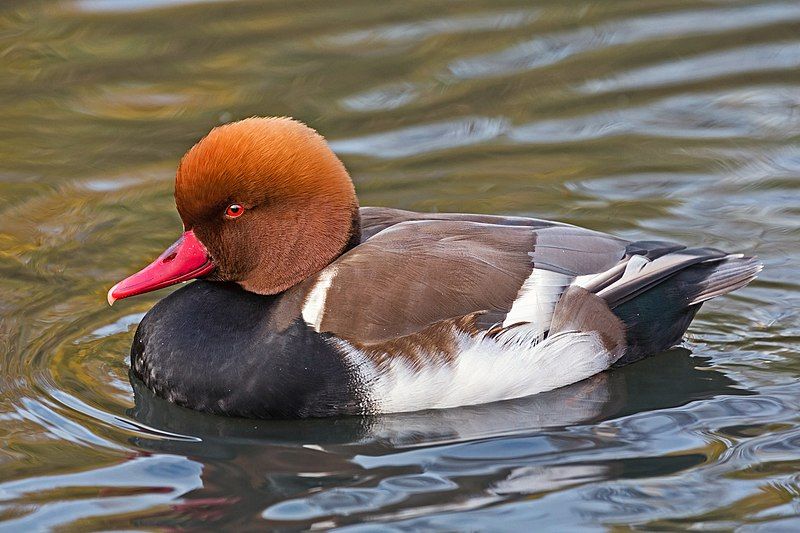
The red-crested pochard is a distinctive species of duck characterized by its large size and unique red crest. It is native to several regions across the globe, including parts of Europe, Asia, and Africa.
The scientific name for the red-crested pochard is derived from two words: the Greek word “Netta,” which translates to “duck,” and the Latin word “Rufina,” which translates to “golden-red.”
This references the impressive red crest, a defining characteristic of this duck species. The red-crested pochard is a relatively large duck with a body length of up to 24 inches.
Its plumage is generally reddish-brown with lighter patches on the sides and back. The most distinctive feature of this species is its red crest, which is prominent in both males and females.
The male also has a dark green-black head and a white chest and belly. The red-crested pochard is an aquatic bird that spends most of its time in shallow water. It is an adept diver and uses its long bill to feed on aquatic plants and insects.
This duck species is also known to be quite vocal, with a distinct call often heard in the early morning and evening. Overall, the red-crested pochard is a unique and impressive species of duck.
Its red crest is distinctive, and its diving skills make it an impressive sight. It is a pretty common species and can be spotted in many different areas worldwide.
| Kingdom | Animalia |
| Phylum | Chordata |
| Class | Aves |
| Order | Anseriformes |
| Family | Anatidae |
| Genus | Netta |
| Species | N. rufina |
13. Ferruginous Partridge
The Ferruginous Partridge is a bird species belonging to the Phasianidae family. It is the only bird in its genus, Caloperdix. This bird species can be found in Indonesia, Malaysia, Myanmar, and Thailand.
These birds typically inhabit dense forests near water sources, such as rivers, streams, and wetlands. They feed mainly on insects, seeds, and small fruits. They prefer to stay in small groups and are very shy and wary when disturbed.
They are known to be quite vocal, often making loud calls during the day and at night. The Ferruginous Partridge is an essential bird species, as it helps maintain the balance of the local ecosystem.
It helps keep the insect population and other small creatures in check while providing food for predators. This species is currently listed as “Least Concern” on the IUCN Red List and is not threatened with extinction.
| Kingdom | Animalia |
| Phylum | Chordata |
| Class | Aves |
| Order | Galliformes |
| Family | Phasianidae |
| Genus | Caloperdix |
| Species | C. oculeus |
14. Great Crested Grebe
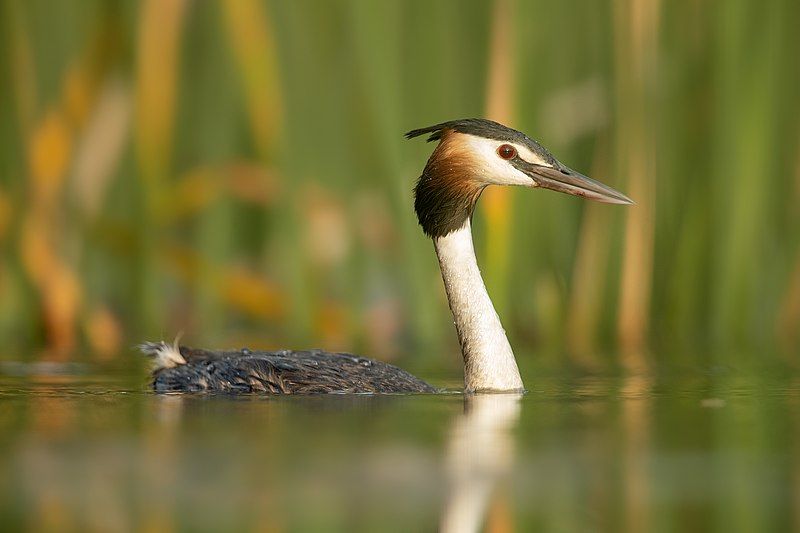
The great crested grebe is a bird species of the grebe family, composed of over 20 birds inhabiting freshwater lakes and rivers. These water birds are known for their elaborate mating display, a courtship behavior used to attract a mate.
During the display, a pair of great crested grebes will engage in a synchronized dance, passing a twig or a feather between their bills. They will also nod their heads and turn their bodies in unison.
The display culminates with the birds diving into the water together. This courtship display is thought to be an essential part of the pair bonding process, allowing the grebes to select a compatible mate.
Once a pair has formed, the great crested grebe will remain monogamous until one dies.
| Kingdom | Animalia |
| Phylum | Chordata |
| Class | Aves |
| Order | Podicipediformes |
| Family | Podicipedidae |
| Genus | Podiceps |
| Species | P. cristatus |
Conclusion
Birds in Kayin are an essential part of the ecosystem, providing food, shelter, and other resources to the people and animals living there. They are also a source of joy and beauty and connect to nature and the outdoors.
The importance of conserving and protecting birds in Kayin cannot be overstated, and efforts should be made to ensure their continued survival.